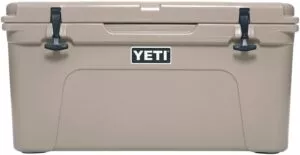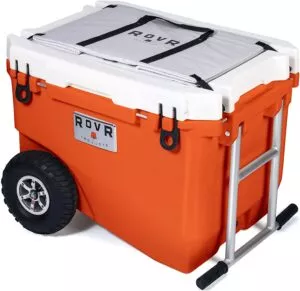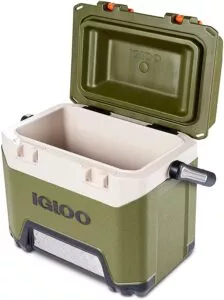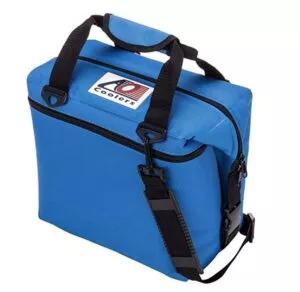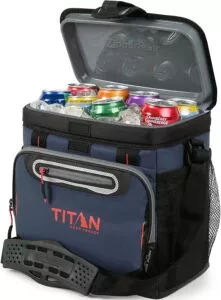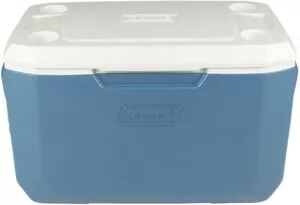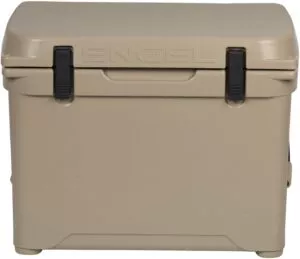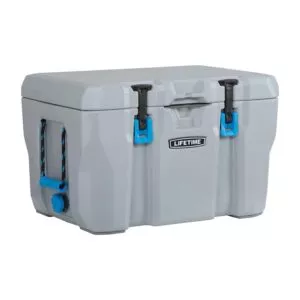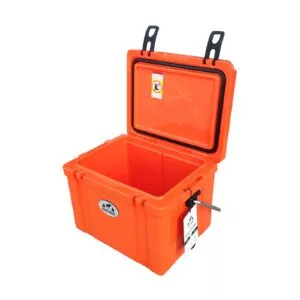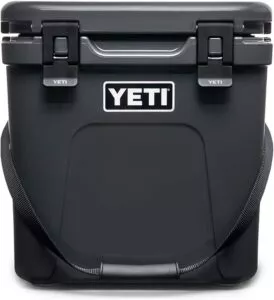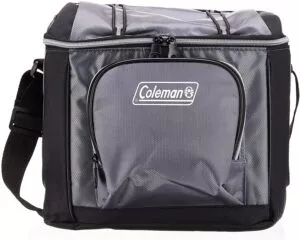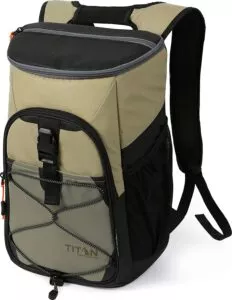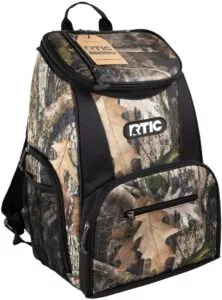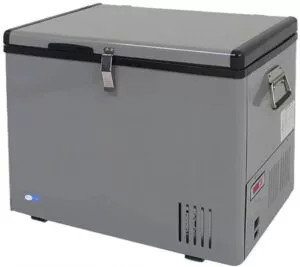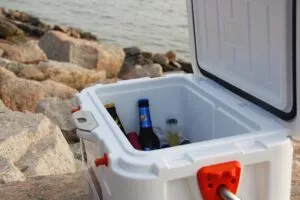
The Best Coolers In Canada
As the weather gets warmer, outdoorsy people across Canada look months and months ahead to start planning their big excursions – myself included. While looking into campsites, trails and activities is a big part of planning summertime adventures, making sure your gear is in order to enjoy the comforts of home away from home is a very big consideration too. There nothing better than a cold beverage after a hot day in the sun, but if your cooler is not doing its job, that simple pleasure becomes a lot less simple.
Luckily, the cooler market has grown drastically over the last ten years. More and more coolers are entering the market with incredible ice retention, durability and extra features that can help make your camping experience special without stopping for ice every few days. Whether you are a weekend warrior or expert outdoorsman, our goal is to help you find that perfect cooler for your next camping trip.
Below, you will find our list of the best coolers available in Canada.
Our top picks
How to choose a cooler
Coolers have one primary job: keeping food and drink cool. However, there are many factors that can influence the degree that a cooler can do that job. Different materials, sizes, and features can influence how long a cooler can keep its contents cool. Here are a few factors you should consider before clicking “buy now”.
- Construction: How a cooler is designed is the most important determinant for how well it will perform. Different materials provide different benefits. Almost all hard coolers are made from hard plastic, and all soft coolers will have a combination of fabric, plastic and foam. Hard coolers in general have much better-quality insulation, but are often heavier to lug around, where soft coolers are easier to carry around but typically warm up considerably faster. More and more coolers these days feature rotomolded plastic – a process that leads to single one-piece plastics that are more durable and have higher potential for insulation than others but are very heavy and typically pricy.
- Cooler Size: We are referring here to the size the cooler itself will take up, which is significant to know in terms of transport and placement. For those who need a cooler for boating, knowing which size of cooler will fit your boat best will be a smart consideration. Likewise, knowing if a cooler can fit in the back of your vehicle can be important and make-it-or-break-it for users like myself, with a small car.
- Storage Size: Storage size refers to the amount of food and drink you can fit inside your cooler and may be the most important difference for some people. Ideally, you want a cooler that can hold all your food and drink for a typical use, as well as enough ice and ice packs to keep everything cold. While hard coolers usually refer to their size in quarts, soft coolers refer to their size in how many cans they can approximately fit. Approximately one can takes up 0.75 quarts of a hard coolers’ space. When shopping for a cooler, consider that between 30 to 50% of the space in the cooler should be used for ice. For two to three people out on a weekend excursion, between 50- and 60-quarts sound suffice.
- Transportability: When it comes to the transportability of a cooler, think about how much the cooler weighs and how other cooler can be picked up or moved. Most coolers will have handles on the sides suitable for moving, but bigger coolers might be too large and unwieldy for one person transport. Other options for transport include roof mounted handles, shoulder straps and wheels.
- Use: Ultimately, how you usually use a cooler will greatly influence what cooler you need. If the extent of your cooler use is keeping your drinks cold while out camping or spending time outside, you do not need an expensive cooler, and a cheap hard sided cooler would suffice if you packed it properly. If you are looking for a cooler for your weeklong excursion miles away from civilization, a premium cooler would then be better suited for your use.
Why trust us
With so many coolers on the market and so much new technology in cooler development, it has never been harder to shop for a cooler. That is why we undertook the creation of this buying guide. We spent almost 30 hours researching the best coolers available in Canada, so you would not need to.
We poured over countless comments on many different models to understand what users liked and did not like about their coolers. We backed up our findings with product analysis including www.outdoorgearlab.com, whose extensive tests on the ice retention of coolers helped us realize which product’s claims were accurate and which were exaggerated. We only incorporated products with an average online rating of 4-stars or higher.
The best cheap hard Cooler
Coleman Xtreme 5
While modern coolers have incredible ice retention and durability, if your trips do not extend much longer than a long weekend, chances are you can get by with something less rugged and expensive. Coleman has a long-established reputation for excellent coolers, and while it may not lead the cooler world anymore, if you want a hard sided cooler without breaking the bank, we think the Coleman Xtreme 5 is one of the best budget coolers available.
For some, you will be able to accomplish more with less, and this is true with the Coleman Xtreme. Thinner insulated walls mean this cooler is significantly lighter than the higher-rated coolers, which can make transport of this cooler much easier. The wheel options available also can help transport your cooler, although sometimes wheels on coolers can mean more frustration than they are worth.
While less insulation means this cannot fully compete with more expensive coolers, this cooler can have surprising results – with ice retention lasting up to 4 days in OutdoorGearLab’s test. However, due to the lower levels of insulation, I do not expect these results to be recreated out in the wild or at a campsite, unless you are smart about preparing, packing and storing your cooler. Realistically, we expect this cooler to provide 2-3 days of chill without re-upping on ice.
While this cooler is basic overall, there are a few additional features that are solid on this cooler. The lid is sturdy, easy to clean and has cup holders – showing Coleman really understands how coolers are really used on the campsite.
Otherwise, this cooler provides little else. There are several things that could be improved upon: an effective gasket to increase the insulation, locking or simple closing mechanisms, interiors capable of being compartmentalized with add-ons – but that is not what this cooler is. Coleman attempts to do the main job of a cooler, and little else, cheaply and effectively.
However, the cooler does have flaws, as the handles and hinges do not inspire confidence. The handles project at an angle so that when carrying a full cooler, the handles are awkward and may bend with the weight. While the hinges are cheaply constructed and may not stand the test of the weight of the lid itself, let alone the test of time.
Users really like the price point and lightness of the Coleman Xtreme, which combined with the surprisingly solid insulation of this cooler make this easily one of the best budget coolers available. While it does not have the durability, insulation or features of many modern coolers, you can go through four or five of these coolers before you begin to hit the price range of comparably sized roto-molded coolers. However, this cooler will struggle on longer trips or for keeping your catches cold, so we do not avoid pushing this cooler past its’ limits.
The Coleman Xtreme 5 is available in 4 sizes: 50-, 62-, 70- and 100- quart models, and is also available in a wheeled model.
Pros
- Lightweight.
- Decent ice retention – granted you are smart about your cooler use.
- Inexpensive.
Cons
- Hinges and handles feel cheap.
- Improvements to lid could improve insulation.
Best rotomolded cooler
Yeti Tundra
Like the namesake implies, this is a monster of a cooler that stays cold. While Yeti’s are renown for their superior quality and insulation, they perhaps are more known for their price-tag. If you are looking for a “buy-it-for-life” cooler, Yeti certainly delivers and is one of the best on the market. However, you can find comparable rotomolded coolers for cheaper, that will be able to do similar things a Yeti can, just without the Yeti name.
Yeti makes their coolers by rotational molding plastic, which is a process that results in one-piece plastics that feature consistent wall thickness and durable corners, that Yeti then pumps with up to 3-inches of pressure-injected polyurethane foam for superior ice retention. This process is one of the superior ways to make coolers, and many companies have followed suit. Yeti then designed their cooler to eliminate as much heat escape as possible, with an interlocking lid system and a freezer quality gasket.
With the incredible amount of insulation in this cooler, this cooler can have incredible ice retention, with the Tundra 65 retaining ice for six and a half days in OutDoorGearLab’s test – solidly putting the Yeti Tundra as the number 1 cooler in ice retention. It is important to note that any test of cooler ice retention is going to vary from the actual results of keeping your food and drinks cold – but these coolers stay cold, even keeping frozen food frozen for many days. We still recommend pre-chilling your cooler and opening minimally if you need to keep things cold past the 3-day mark.
Each component of Yeti coolers has had a lot of thought put into them to ensure durability. The resulting cooler is strong enough to withstand a hungry bear, and so the cooler has earned a “Grizzly resistant” certification from the Interagency Grizzly Bear Committee, granted the Yeti is locked by a bearproof locking mechanism (sold separately). For those who are looking for a great ice box for fishing, the Yeti features heavy rubber footing so it will not slide around inside your boat.
However, with the durability and insulation as the priorities of the Yeti Tundra, there are a few issues that may make you consider another cooler. The thick walls of the Yeti borrows from the interior space available, so most Yeti coolers are a few quarts shy of what you would assume is the size (for example, the Tundra 65 is closer to 56 quarts). With the durability the thicker walls provide, this cooler is also significantly heavy, with a dry weight of the 65 being 29 lbs. This makes buying a larger Yeti inadvisable if you must do any hiking to do before reaching your hiking or fishing spot.
Users for the most part are ecstatic to own their own Yeti. Users comments that usually they had a Yeti on their radar for a long time before buying, and while some are skeptics, the Yeti routinely stuns users with the level of cold the Yeti maintains for days. However, with this being said, there are some aspects of this cooler that may lead you to pass on it for something else.
The price has been brought up already, and while this is an excellent cooler, you will be paying partially for the Yeti name – a fantastic marketing campaign has made Yeti a luxury good in many people’s eyes, and so people flock to Yeti’s more for the nameplate than the ice retention. That does not take away from the excellence of the Yeti Tundra as a cooler – but you will likely be able to find a similar cooler for cheaper. If you want an excellently performing cooler that can last years – and just might be the last cooler you ever buy, we recommend Yeti.
The Yeti Tundra is available in a wide range of sizes from 35 to 350 quarts, although the larger sizes are retailed for industrial or medical purposes primarily. A wheeled version of the Tundra, the Tundra Haul – is also available if you do not want to lave to lug your Yeti very far.
Pros
- Excellent ice retention.
- Excellent durability.
- Loaded with features.
Cons
- Bulky and heavy.
- Expensive.
Best cooler insulation
Engel Deep Blue
The Engel Deep Blue series is another beast of a Roto-molded cooler that has turned a lot of heads for its incredible durability and ice retention. In terms of Yeti alternatives, this is an effective one that will provide similar results at a price that can be much cheaper.
When the Amazon description describes this cooler as having “best in class ice retention” – they are very close to correct. Engel’s Deep Blue line are constructed from 2-inch layer of rotomolded polyethylene for excellent insulation and durability. While the company’s 10-day claim of ice retention are a stretch to put it lightly, this cooler has performed incredibly in tests, maintaining ice in hot conditions for over 5-days – even beating the Yeti Tundra out in a few tests.
This cooler is bear-resistant by the Interagency Grizzly Bear Committee (IGBC), granted you combine this cooler with bear-resistant locks.
With a silicone gasket for an-almost airtight seal that helps keep the cold in, and adjustable yet durable draw latches that are easily opened by one hand, Engel has got the basics of the premium rotomolded cooler down. The result is a powerful cooler that is comparable to the Yeti – while being cheaper and slightly lighter to boot. Unfortunately, the limited availability of Engel’s coolers in Canada means the savings you would receive might be minimal, but great deals can be had if you look.
There is not a lot of negatives to say about a cooler of this quality. One thing to look out for is that Engel does not offer its’ impressive 10-year warranty through third party sellers, which apparently includes this amazon seller. Another criticism is that the interior space of this cooler is small, but the thicker walls of Rotomolded coolers make this an overarching criticism of this style of cooler.
Users generally really like using Engel’s Deep Blue line of coolers for their impressive insulation, durability and construction at a price cheaper than other high-end coolers. Additionally, Engel coolers are one of the lightest rotomolded coolers available. However, the performance of Engel coolers is less consistent than that of Yeti’s, with more parts that have the potential to fail, like rubber latches that are more prone to stretching, or other parts that do not offer the same luxury as other coolers, like the Engel’s uncomfortable rope carry handles. All in all, this is a solid alternative rotomolded cooler for those who want the performance while potentially saving some money in the process.
Engel Deep Blue coolers are available at sizes from 25 quarts to 165 quarts.
Pros
- Excellent ice retention.
- Durable construction backed up with a nice warranty.
- Loaded with features.
Cons
- May be harder to come by in Canada at a competitive price.
Best budget heavy duty cooler
Lifetime High Performance Cooler
When you are paying top dollar for a product like a Yeti or an Engel Deep Blue, there is an expectation that these products are going to last, on top of their great performance. Lifetime is a company that has moved into the Cooler market recently and offers a line of high-performance coolers at a price that will surprise you. While we have doubts about the durability of these coolers, overall positive reviews and a price that is hard to beat make the Lifetime line of coolers one that will intrigue many.
With a rugged, bulky design, you might assume that the Lifetime High Performance line of coolers are similarly rotomolded. However instead, Lifetime utilizes a similar process called blow molding, which works similarly but is a cheaper process that results in thinner plastics. While ultimately this may be impactful on the durability of these coolers, it is worth noting that these rugged coolers are still strong enough to withstand a hungry grizzly for an hour.
The resulting cooler is thick-walled and sturdy, with plenty of features to keep up with other more expensive coolers that Lifetime compares themselves against. Featuring an improved gasket, easily manipulatable rubber latches, grippy rubber feet and an easy-to-drain spout that can attach to a garden hose, this is a great cooler for the cabin, the campground or the boat.
While Lifetime claims that their coolers can retain ice for between 5 to 9 days, we have our doubts about this level of longevity in this cooler in the field. However, this cooler should suffice for a trip over a long weekend, and some users have reported 5 or 6 days of ice retention with the larger Lifetime coolers, so overall the Lifetime seems to have decent ice retention.
The main issue of the Lifetime line of coolers is an unfortunate one – the lid is prone to warping, meaning some users are unable to seal this cooler – even after only a few uses. A video uploaded by Lifetime suggested that warped lids may be a result of contact with direct sunlight, and can be reversed, but with little follow up from disappointed customers, we are unsure if this is an effective solution.
Lifetime has fixed the issues of their coolers in the past, fixing problematic gaskets to improve spotty ice retention in the past. It seems as if the 65-quart cooler is a newer version, so these issues may have been remedied. As a company, it seems as if Lifetime really stands behind their products and have great customer service, which is promising if a cooler has big flaws like this one.
Users are impressed with the quality of cooler they get for the price with Lifetime’s line of coolers, getting solid ice retention, rugged construction and a decent number of features that will make many think this cooler is more expensive than it is. While this cooler does seem to be an excellent deal, these issues with warping are concerning and we hope that Lifetime has improved the design to prevent this in the future.
Lifetime features coolers from sizes from 28- to 115- quarts, and recently added a 55- quart cooler with wheels into their lineup.
Pros
- Solid ice retention.
- Inexpensive price point.
Cons
- Lid and front are prone to buckling or warping.
Best wheeled cooler
RovR RollR
Modern coolers can be heavy – a fully loaded cooler can easily be upwards of 50 pounds, and Rotomolded coolers can exceed that full weight significantly. For some, carrying a cooler of this weight for any duration is a no-go. If you are looking for the cooler with the best wheels available, we invite you to look no further at the RovR Rollr 60 – a large rotomolded cooler that you can wheel along wherever you go. And we really mean that.
Many coolers that feature wheels run into the major issue of the wheels just not being any good. Plastic discs may suffice on sidewalks and on grass, but difficult terrain commonly found at campsites may prove exceptionally frustrating. RovR instead goes the opposite direction, incorporating rubber pneumatic tires into the design so this cooler can tackle different types of terrain without stopping or cursing. You do not have to worry about sharp rocks and sticks nullifying this mobility either, as each RovR Rollr comes equipped with thick, puncture resistant tires.
On top, the RovR’s cooler is pretty great too. The thick-walled, roto molded cooler has excellent ice retention and durability, that is certifiably grizzly resistant from the IGBC. With an airtight gasket, and rubber latches, this cooler keeps things cool for many days at a time. In OutdoorGearLabs’ ice retention test, the RovR solidly got 4, almost 5 days of optimal cooling temperature.
Additionally, this cooler has a lot of goodies, as well as add-ons for an infinitely customizable experience. Included with the cooler is a Deepfreeze dry bin, which can separate your cold cans from the food best left dry, and a Wagon bin that can store dry good that do not mind the heat on top. Add-ons you can consider with this cooler include The Essentials Pack that includes an attachable cup holder, cutting board and stash bag, an attachable umbrella stand for rain or shine conditions, and an attachment so you can pull this cooler with your bicycle.
However, there are some issues that the RovR Rollr has. While heavy duty wheels cover lots of terrain, there are certain terrain types this cannot travel over, and lifting this icebox when the going gets tough is just going to make things tougher – the dry weight of this cooler is 50 pounds. For its price, there are coolers with better insulation that will last you longer. Finally, the price of this cooler is quite high.
Users overall are very impressed with the RovR Rollr. For a cooler that does everything so well, and has the bonus of actually usable wheels, this cooler solidly deserves one of the highest grades on this list – and users agree. If you are not camping out of your car and need to travel to get to where you are going, in most conditions we recommend the RovR. However, if carrying the cooler is an inevitability, we suggest you consider something a little lighter.
Pros
- Pneumatic rubber tires can take on most terrain.
- Extremely durable.
- Range of add-ons help customize your cooler to your experience.
Cons
- Very heavy.
- Very expensive.
Best Canadian cooler
25L Chilly Ice Box
Chilly Moose are a Canadian company that designs ice boxes and more. With a range of rotomolded ice boxes with different sizes available, Chilly Moose is an upcoming company that is poised to make a good first impression with many Canadians this summer.
With a rugged rotomolded construction that features 40mm of pressure injected insulation in the walls, Chilly Moose coolers are designed with maximum ice retention in mind. Even their smaller 25L ice box can keep beers cold for up to 3 days, which is impressive as the bigger coolers typically get, the more ice they can retain in ideal conditions. Complete with a form-fitted interlocking lid that seals for maximum insulation, a durable interlocking hinge that is built to last, and durable rubberized handles, this cooler seeks to compete with the top coolers, and seems to do just that.
Chilly Moose offers a lot of excellent features and add-ons for their coolers, including the capability to add a divider that doubles as a cutting board or cooler baskets, that are also available on their website.
In terms of flaws, there is not a lot to report in terms of the Chilly Moose Ice boxes. Users are generally very happy with their Chilly Moose, easily keeping the user’s food and drinks cold up to 5 days. One user had issues with the rubber feet falling off, but otherwise the company seems to have a quality product on their hands. This easily could be Canada’s response to the Yeti and is an excellent option for a rotomolded cooler for Canadians that will not be subject to large shipping fees, the short end of the exchange rate, or unavailability that make many of the best performing rotomolded coolers suboptimal choices for Canadians.
Chilly Moose offers coolers in sizes from 12L to 120L (note the size is in litres) including several coolers that featured wheeled options.
Pros
- Excellent Rotomolded construction.
- Durable.
- Canadian designed and based company.
Cons
- Rubber feet may come off.
Best budget cooler
Igloo BMX
Another solid performer, the Igloo BMX line is a great budget cooler that has impressive ice retention considering its price. Of the line, the Igloo BMX 25 is perhaps one of the best solo coolers on this list, for its solid ice retention, lightweight construction and affordable price.
This is another melt blown cooler that is much more inexpensive than similar rotomolded coolers, yet still provides solid results in terms of insulation and durability. If you want a powerful cooler without paying the premium price for a rotomolded cooler, melt blown coolers naturally make a lot of sense.
In OutDoorGearLab’s tests of the Igloo BMX 25, this cooler was able to maintain sub-4-degree Celsius temperatures safe for refrigerating food for over two and a half days – one of the longest times for a personal cooler the publication has tested. This makes the BMX 25 perfect for keeping drinks cold or storing food for a weekend trip.
However, this cooler does not have a watertight seal, which means that cold air can escape and reduces this cooler’s ice retention. If Igloo added a decent gasket to improve the seal of this cooler, we have no doubts that this cooler’s performance would get better.
These coolers feature thick walls that improves the durability, while still being very lightweight. This combination makes this an excellent companion for a road trip or picnic, and the larger sizes should be a solid option for weekend camping trips. The space inside is decently spacious, able to carry wine and pop bottles upright.
There are a few nitpicks that can be made about this cooler, but should not be read to much into, unless they are actual dealbreakers for yourself. Since there is no watertight seal, a bump car ride can spill water into the vehicle. No rubber feet mean this cooler might slide around your vehicle if you let it. The lid is not designed for comfort to sit on and is angled slightly making it an imperfect surface to place your drinks on.
Overall, users really enjoy the Igloo BMX line of coolers as an affordable cooler with solid performance and durability. While these coolers are not perfect by any stretch of the word, the shortcomings are typically minor and adaptable – one user fixed their own gasket onto the cooler and saw positive results instantly. While this cooler is a little bit more expensive than the Coleman, we think you can get more use out of the BMX Igloo.
The Igloo BMX is available in 25 qt-, 52 qt and 72 qt- sizes.
Pros
- Durable.
- Lightweight.
- Inexpensive.
Cons
- Seal is not watertight.
- Some features were excluded to improve price.
Best personal hard cooler
Yeti Roadie 24
If you are looking for a cooler with top-of-the-line quality, but do not need significant size, you might be into the Yeti Roadie 24, a more manageable sized Yeti that is great for weekend trips and picnics. With the storied Yeti quality (and storied Yeti price), this is an excellent cooler for those who need something on the smaller side.
Featuring the same rotomolded construction as Yeti’s larger coolers for excellent insulation and durability. In terms of shape and size, the Roadie 24 is a significant improvement over Yeti’s Roadie 20 – having both more space and less weight than their previous model. The cooler is easily tall enough to pack 2-litre pop bottles and wine bottles, making this an excellent drink cooler no matter what your drink of choice is.
Additionally, the Roadie features a Quicklatch system that is rugged yet accessible with one hand, which is much easier than the Yeti’s Tundra’s rubberized latches. Combined with Yeti’s dependable Neverfail hinge system, this cooler is built to last and keep drinks cold.
There are a few things we feel Yeti could improve on with this cooler: for instance, the carrying handle is uncomfortable and the strap is on the short side, so carrying this cooler can be awkward in certain carrying set ups – uncomfortable over the shoulders and can bash your shins if you are carrying by hand and are not careful. Another flaw that could easily be amended is the lack of a drain, which makes draining the inevitable meltwater more of a task.
Like most Yeti coolers, this one tops the price range of coolers of this size. While this is a durable and effective cooler with excellent ice retention, you are paying for the Yeti name on top of all these features, and we think there are similarly effective coolers in this size range that are hundreds of dollars cheaper.
Users seem to really enjoy the Yeti Roadie for its excellent ice retention and build quality. If you need to keep only drinks cold for a long weekend or longer trips, this is the best performer for that category. However, the price will understandably be a big deterrent for some. While the best cooler of its size range in, the improvement of the Yeti Roadie over the Igloo BMX is marginal, and the Igloo is significantly cheaper.
Pros
- Excellently durable.
- Great Ice retention.
Cons
- Expensive.
Best soft cooler
AO Coolers Soft Cooler
While this cooler does not look like it can compete with top-of-the-line soft coolers, the AO Coolers soft cooler is perhaps one of the better options for soft coolers, in terms of performance and price.
The AO Soft Cooler has impressive ice retention and insulation that competes with soft coolers that are significantly more expensive. Insulated with ¾” of high-density Polyurethane Foam, that is protected from water leaking with an effective leak proof liner on the inside, the AO Coolers soft cooler can keep refrigerator temperatures for up to two days.
While the company claims their cooler is “guaranteed not to leak or sweat,” the bag is not totally waterproof, as the zipper is not watertight and will likely leak if it falls over onto its side. However, the interior liner has effective waterproofing that you can rely upon, and the bonus with the zippers is that they are easier to work with and do not require lubrication like some watertight zippers do.
While many soft coolers will have a plastic lining to help the cooler keep shape and durability, the AO Cooler is entirely soft, which improves flexibility for packing. An additional zipper pocket on the outside that extends the length of the bag for anything that needs to stay dry or does not need to be kept cold.
Users overall really enjoy these coolers: they are great for day use, and very light and compact. Many users commented that they were surprised at these coolers, as they seem to be a bit bigger than what they are described as, to allow appropriate amounts of ice on top of the listed size.
Pros
- Decent leak protection if upright.
- Lightweight.
- Inexpensive.
Cons
- Zipper can leak.
Best budget soft cooler
Arctic Zone Titan Zipperless Cooler
Soft coolers are typically no where near the same level of premium hard coolers in terms of insulation, durability or versatility, but that does not mean they are not worth your time – you just need to know which to get. The benefits of soft coolers can outweigh the lesser performance, especially if you prioritize ease of mobility over insulation. However, the Arctic Zone Titan Deep Freeze is no slouch in terms of insulation either.
While soft coolers are not ideal for long trips where the quality of your food relies on keeping your food chilled, they are solidly effective for keeping drinks cold for up to a weekend, or as a heavy-duty lunch kit when the nearest fridge is miles away. The 30-can version of the Arctic Zone Titan is able to maintain fridge temperature for just under 2 days in OutDoorGearLabs’ test, which may not be enough for storing food for a weekend but is excellent for keeping your drinks cold.
Inside, the Arctic Zone Titan features a hard plastic liner that improves the durability of these coolers and helps them retain their shape, while also including Arctic Zone’s Smartshelf, where you can store food or other things away from the ice. Combined with a rugged fabric exterior, and triple layer Cold Blockbase insulation make this quite the effective soft cooler.
While many soft coolers feature zippered enclosures, the Arctic Zone Titan is zipperless, with a plastic lid that presses into the top of the opening like a hard cooler would, with a little bit of Velcro to ensure the lid stays shut. This construction seems to do a solid job of insulating whatever you put inside of it, even if it is not waterproof.
Users overall love the value and performance that the Arctic Zone Titan provides. While users do enjoy the Arctic Zone Titan as a drink cooler for camping or road tripping, we noticed many users who very happily use these soft coolers as a lunch kit. These coolers are excellently effective at keeping things cold fore shorter periods of time, but we recommend opting for a hard cooler if you need things to stay cold for longer.
The Arctic Zone Titan Deep Freeze cooler is available in 16-, 30- and 48- can sizes.
Pros
- Solid insulation for a soft cooler.
- Inexpensive.
Cons
- Not watertight.
Best cooler lunch bag
Coleman 16-can Soft cooler
If the extent of your cooler use is going to be transporting drinks between home and backyard gatherings or days on the gold course, go ahead and buy a trusty Coleman. This 16 can soft cooler does what is asked of it: keeps food or drinks cold for short periods of time and does so cheaply and effectively.
This Coleman cooler features a plastic liner inside to improve the insulation and resistance to leaks, that is also handily antimicrobial – great for anyone who has left their cooler too long and met with a smelly cooler or worse. In terms of cooler performance, this cooler is unspectacular comparatively to many of the coolers on this list but will effectively be able to insulate your cans enough that it will be enough for a barbecue or a picnic. For the price of this cooler, the performance you get is enough to make this Coleman soft-sided cooler a great lunch kit or grocery store companion as well.
This cooler is designed to hold up to 16 cans, however with ice inside you will struggle fitting 16 cans inside, and the cooler is not large enough for keeping a 2L pop bottle inside, either. With a zippered pocket on the outside and mesh pockets both in and out, there is plenty additional storage space for any extras you may have, like bottle openers, utensils, or dry snacks. However, due to these size limitations, for any outing longer than a day, you might be better off looking for something larger.
With easy-carry straps and handles, this cooler is easy to move around, which is also improved by the lightness of the construction of this cooler. This cooler is the perfect size for taking back and forth with you for short outings, or to work.
Overall, users really appreciate this Coleman cooler for taking lunches to work or taking drinks to hang out. However, this cooler is ill-equipped for storing food that needs to be kept chill for over a day. This is a great cooler for the road trip, but might be a little small for a picnic, but we advise for springing for something with more insulation if you want to take out into the bush.
Pros
- Very portable.
- Affordable.
Cons
- Not very well insulated.
- Dimensions could be improved to carry different kinds of drink containers.
Best cooler backpack
Arctic Zone Titan Deep Freeze Backpack Cooler
We really like the Artic Zone Titan Deep Freeze for a soft-cooler, and the backpack version of the cooler is also a capable product that can help carry your drinks and food with you for a day trip. If you want a cooler that is easy to walk with, we think backpack styles provide the most comfort while also providing the space needed to carry several cans and ice.
While sharing a name with their soft cooler, it is important to note some distinctions between the construction of both Arctic Zone Titan Deep Freeze coolers on the list. For example, the backpack lacks an interior hard plastic liner that helps maintain the insulation and shape of the cooler. Instead, the backpack version has a more typical soft construction.
With Rhino-Tech exterior that is both water and stain resistant, this bag should be able to handle the elements decently. While the interior of the bag is designed to be leak proof, it is important to note that this bag does not feature waterproof zippers and so water can potentially leak from the zipper. This is an issue shared by several cooler backpacks, and we suggest buying a couple of appropriately sized ice packs instead, to prevent the bag becoming soaked. However, the interior lining is leakproof, easy to clean, and anti-microbial, so even if you do use a small amount of ice, this cooler should perform well.
While the Arctic Zone Titan is advertised as a 24 can cooler, you will not be able to fit that many cans inside with ice included, but like the non-backpack version is tall enough for wine or pop bottles. According to Arctic Zone themselves, the Titan can retain ice for up to a day at a time, but only if the bag is 50% full of ice.
Unfortunately, this bag seems to have questionable quality control when bought through Amazon, which may suggest some less-than-reputable sellers are to blame instead of Arctic Zone. A few users have had the bag wear in the straps or pockets. While this is an affordable option, the question of durability is important.
Overall, the Arctic Zone Deep Freeze seems like a solid cooler backpack and users are generally happy with its performance and comfortability. If you want a cooler to put on your backpack comfortably, this is a decent option. However comparative to the Arctic Zone Deep Freeze soft sided cooler, there is a trade off in terms of ice retention and durability in return of the handiness of a backpack.
Pros
- Solid insulation for a backpack cooler.
- Lightweight.
- Inexpensive.
Cons
- Zipper is not watertight.
- Quality control may be lacking.
Another great cooler backpack
RTIC Day Cooler Backpack
Soft coolers take away some of the weight and awkwardness of lugging around coolers, but chances are if you are camping, you are going to be lugging around something anyway. If you are looking for an effective hands-free solution, we recommend considering a cooler backpack. Great for day hikes and picnics, we appreciate RTIC’s Cooler backpack for its large size, decent insulation and hand-free performance.
RTIC is a very highly respected brand of coolers and iceboxes that is widely regarded as Yeti-quality for less. While their hard coolers are some of the best on the market (and largely hard to find in Canada), their soft coolers are highly performing as well. This RTIC Day cooler is a great option for road trips, picnics and day hikes.
With an exterior made from heavy-duty polyester and interior lined with high-density insulation, this is a durable, effective cooler. This RTIC Backpack is designed to hold up to 15 cans and keep them cold for up to 24 hours. With decent insulation, this cooler will be great for any day trips, but not equipped for anything longer. Part of the reason why is the insides of this cooler are not watertight – using ice will result in a leaky cooler. Using ice packs is essential with this cooler, and RTIC recommends using two. With mesh pockets for easy access and an easy-to-use zipper for the main compartment and the front zipper pocket, this cooler is easily accessible.
Overall, uses love the ease of use of this cooler, easily taking cold drinks wherever they need to go. However, due to the fact this cooler does not handle actual ice very well, we think this cooler is easily outclassed by other soft options – that will ultimately be cheaper for Canadians.
Pros
- Solid insulation for single day use.
- Very portable.
Cons
- Pricy for Canadians.
- Not water resistant.
Best powered cooler
Whynter FM-45 Portable Refrigerator/Freezer
You might be wondering: isn’t a powered cooler a fridge? And you would be partially right: a powered cooler is for those situations where ice is not enough to keep things cold. Excellent for cabins, trailers, or boats, powered coolers are certainly a niche product, but can be indispensable in certain set ups. For an inexpensive yet effective powered cooler, we recommend the Whynter FM-45G.
The Whynter FM-45G is on the smaller side of things, coming in at just over 40 quarts. While this is on the smaller size comparatively to some of the non-powered coolers available, the fact you do not need ice to keep this cool mean you can make more of the size of the Whynter.
Featuring walls with thick insulation, the Whynter is an efficient machine to keep your food cold and can operate as either a fridge or a freezer, able to sustain temps well below average freezer temperatures. The fast freeze mode lets you reach freezer temperatures quickly, and has a low energy setting to conserve power when needed, that uses only 35 watts – much lower than many other powered coolers available. The cooler can be run from either AC or DC power, with included cables for each set up that should be more than long enough for your set up.
This cooler is trunk style, with two included baskets that let you organize the cooler or look for certain items easily. Equipped with rubber feet to keep the cooler in place, and a drain plug just in case – however it is recommended you do not let this cooler get waterlogged – this is an electrical device after all.
While the Whynter is a solid device, there are some flaws that might make you consider another alternative. One of the most notable drawbacks is the weight – the Whynter weighs almost 55 pounds empty, making transporting the device difficult. However, we feel as if powered coolers are not great for being carried around, and we would think to use them more like you would a fridge: once you find a home for it, it should probably stay. Another annoying feature is the fact the excellent control panel is on the back of the unit, making accessing the controls to change the settings harder.
Some users really enjoy using the Whynter FM45G, as an actual fridge/freezer unit that is small enough to bring camping and can run off a truck engine with minimal power drain. However, this device is not very portable, so it is better suited for cabin or RV use than I would tent camping, unless you can trust your vehicle to power this cooler throughout the trip. For a powered cooler or compression fridge, the Whynter FM45G is a powerful, efficient and bargain purchase.
Pros
- Well insulated and cooled.
- Excellent low power mode.
- Inexpensive compared to some other powered coolers.
Cons
- Smaller interior.
- Heavy.
How we picked the best coolers
With so many coolers now on the market, finding that right one for your upcoming camping or fishing trip might be overwhelming. We found that most people (ourselves included) are looking for coolers that are the right size and provide them with enough insulation that their cooler can stay cold long enough within reason without an ice top up or their food and drink getting warm. However, factors including weight, durability and additional features can also be important for your use of the cooler.
We developed this list by reading product reviews from verified purchasers, while also comparing results from expert product reviewers who pushed these coolers to the limit from trusted sources like outdoorgearlab.com and coolersonsale.com. We picked the best performing coolers from these lists that were readily available in Canada.
Frequently asked questions
How to pack a cooler for camping?
Coolers are essentially just insulated containers. They can keep cold items cold longer, and likewise can keep hot items hot for longer as well. This means if you want your cooler to stay cold, it must start cold too. When packing your cooler, you should ensure everything is cold going into it, and if the cooler starts off cold too, that will be a bonus. One method that works is filling your cooler with ice water the day before you leave, and packing the cooler right before departure.
What will be keeping your cooler cold is ice, but not all ice performs equally. Block ice and ice packs have larger mass so they will melt slower than ice cubes, keeping your cooler cool for longer. One trick that can help is to freeze things like water bottles and non-carbonated drinks, so they can do double duty of keeping the cooler cold as well.
Since most coolers lose heat by the cooler being opened again and again, we recommend packing the items you will use first on top. The more time you spend with an open cooler, the more the cooler will warm up. Another solution is to bring separate drink and food coolers – chances are you will be opening your cooler for drinks more often, and this strategy ensures your food stays at the safe food storage temperature for longer.
Finally, try to pack your cooler tight. More air in the cooler will melt the ice faster. If you follow these steps, you should be able to get solid performance from almost any cooler.
My cooler’s does not keep ice as long as it said it would. Why?
Coolers, like many other products, are extensively tested for results, by both the companies and product testers. However, that is not to say that these claims are going to be one hundred percent accurate or reliable. Coolers are usually tested by companies to get the optimal results, which usually means they are testing how long a cooler full of ice can retain its ice in certain conditions.
Coolers are effectively little more than boxes filled with insulation, and so how long your cooler will stay cold really depends on how cold the contents are inside of the cooler (including the air) combined with the insulation. If you throw a single bag of ice into a cooler, you are not testing the cooler’s insulation, you are testing how long it takes to chill the air inside the cooler. Therefore, it is recommended to pre-chill your cooler and try to fill it as much as possible.
When out camping or road tripping, your cooler is likely going to have food, drinks and ice. With less ice, that means the cooler is going to warm up faster. Combine this with the fact you will likely need to go into the cooler several times per day, and it is no wonder why some coolers that claim they can retain ice for 10 days may only get 5 days of ice retention with real world use.
Which cooler is best?
There is no single best cooler, and what may be hyped up may not suit you. However, there are some coolers that consistently outperform others. If you need to keep food and drink cold for multiple days, while being miles away from the nearest ice machine, rotomolded coolers consistently have the longest ice retention, but are also heavy and typically expensive. For a picnic or road trip where you need to keep food chilled for a day max, we recommend a soft-shell cooler for their superior portability.
What is the best cooler for keeping ice the longest?
In tests, rotomolded coolers handily outperform other versions of coolers in terms of keeping ice the longest, with some able to have ice remaining after 6 days in 30+ Celsius weather. Is this a realistic expectation from what you can expect? Probably not, as chances are you will need to open these coolers more than the testers did and have more food than what the testers did. But under equal circumstances, that Rotomolded cooler will outperform your old Coleman.
Where to buy coolers?
You can find excellent coolers in any store that sells outdoors equipment. Walmart, Canadian Tire and Cabela’s are all great stores for finding your next cooler. Online retailers like Amazon, as well as cooler manufacturers’ website can be great places to shop for coolers online.
Read more
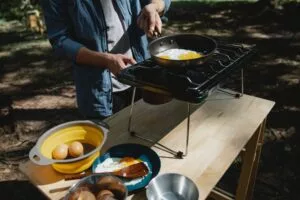
The Best Camping Stoves in Canada
If you want to take your camp cooking to the next level, then a camping stove is the appliance for you.

The Best Camping Tents in Canada
Camping is one of the best ways to get into nature, but without the perfect tent – your trip can go downhill fast.
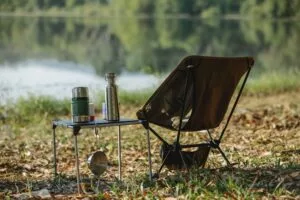
The Best Water Treatment Systems for Backpacking
Even when the water is clear, bacteria and protozoa may be hiding near.
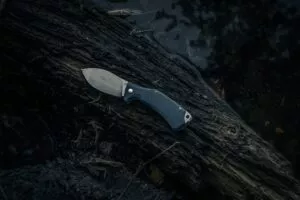
The Best Pocket Knives in Canada
A quality pocketknife can be one of the handiest tools in many situations.
